Critical Thinking and Managerial Decisions Analysis Report
VerifiedAdded on 2022/08/25
|8
|2199
|22
Report
AI Summary
This report critically analyzes two research articles focused on critical thinking (CT) and its application in higher education. The first article, a meta-analysis by Abrami et al. (2015), explores various strategies for teaching students to think critically, emphasizing the importance of CT skills for students' analytical abilities. It discusses methodologies like meta-analysis and the impact of mentorship and dialogue techniques, while also acknowledging limitations such as the infancy of certain tools and the role of age in CT development. The second article, by Cloete (2018), investigates the impact of integrated assessment on the CT skills of first-year university students, employing a quasi-experimental design and the Watson Glaser Critical Thinking Appraisal. This article emphasizes the role of time and guidance in developing CT skills, highlighting the benefits of integrated assessment tools over traditional methods. The report identifies both strengths and weaknesses of the methodologies used, and also emphasizes the importance of CT in higher education and the need for teacher training.
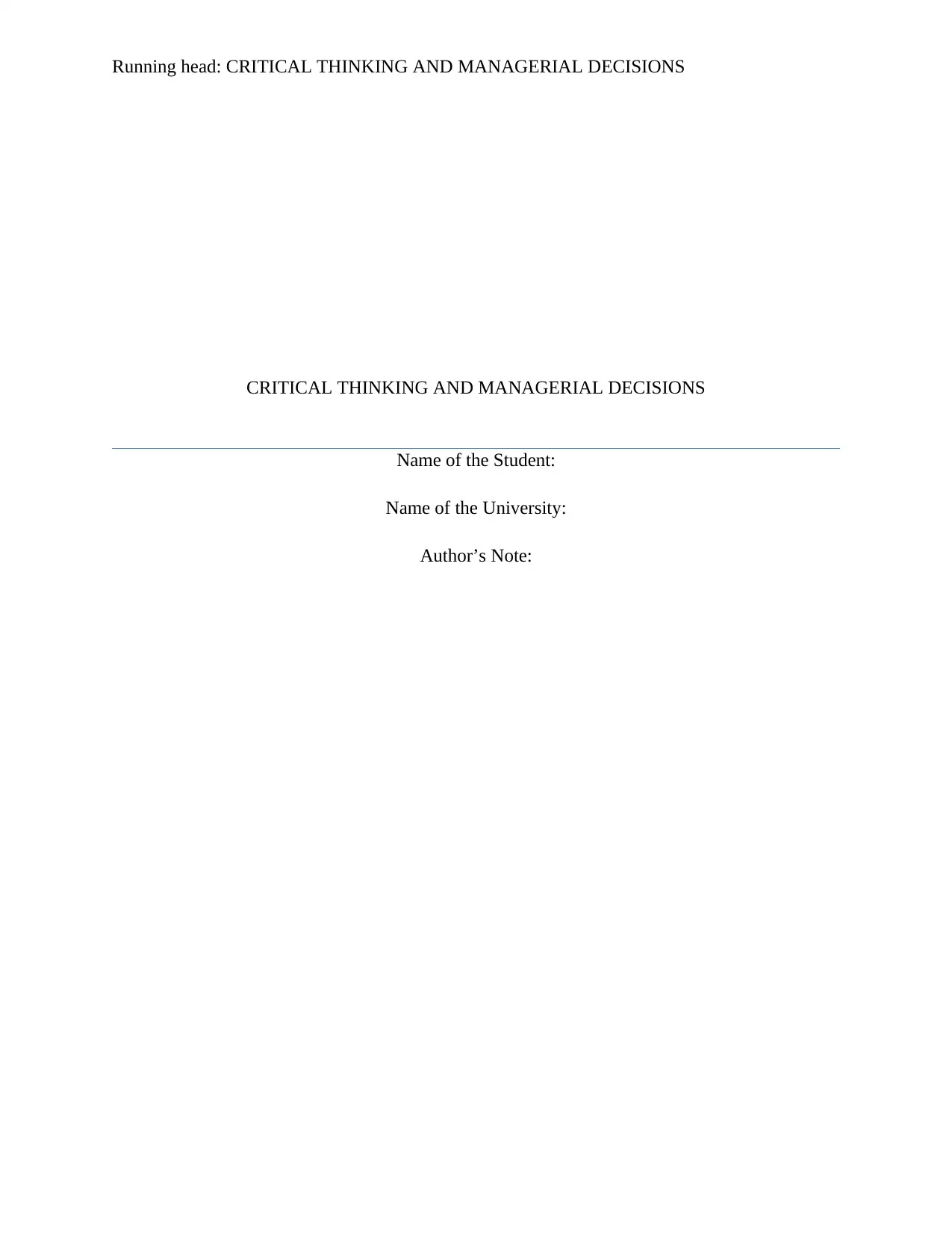
Running head: CRITICAL THINKING AND MANAGERIAL DECISIONS
CRITICAL THINKING AND MANAGERIAL DECISIONS
Name of the Student:
Name of the University:
Author’s Note:
CRITICAL THINKING AND MANAGERIAL DECISIONS
Name of the Student:
Name of the University:
Author’s Note:
Secure Best Marks with AI Grader
Need help grading? Try our AI Grader for instant feedback on your assignments.
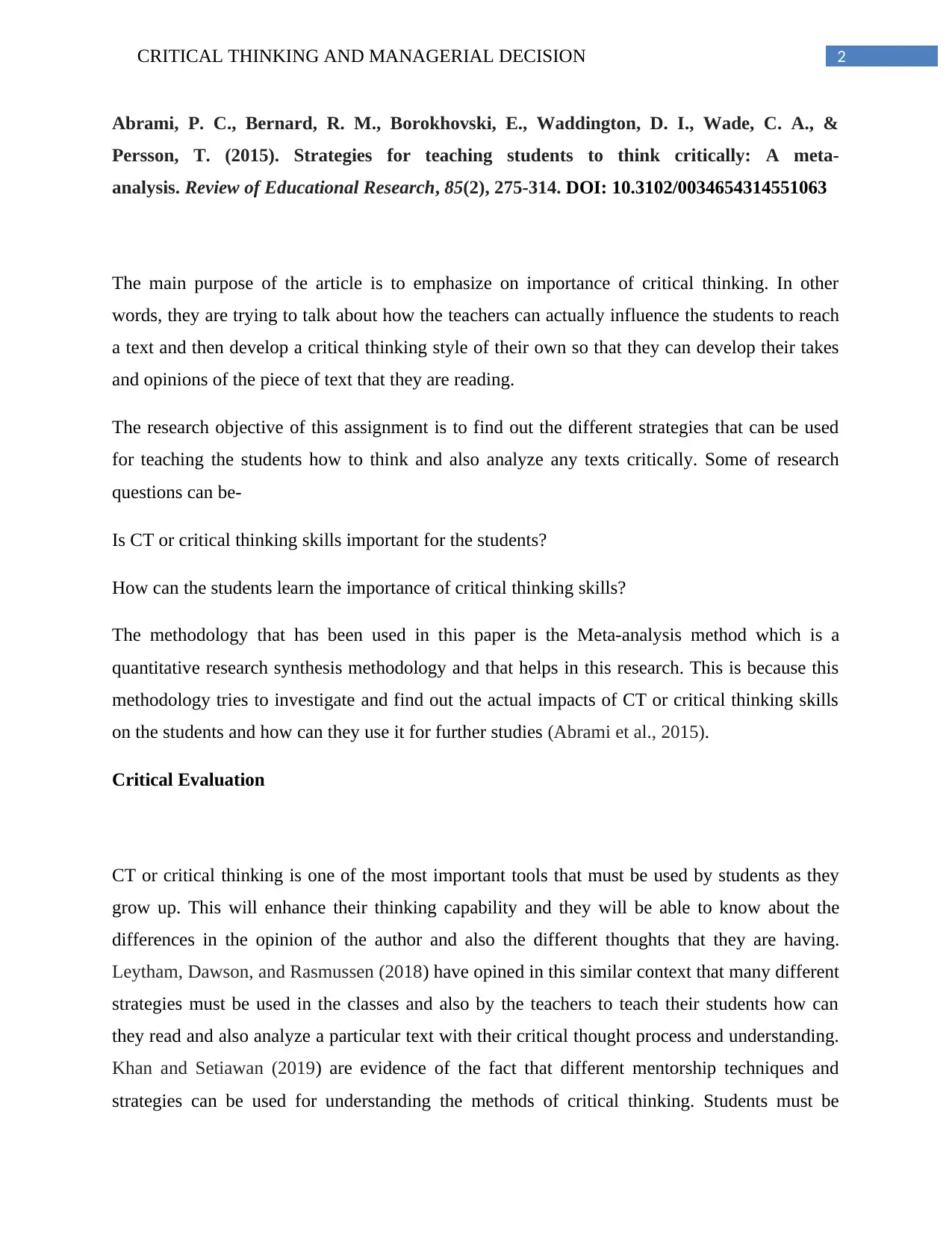
2CRITICAL THINKING AND MANAGERIAL DECISION
Abrami, P. C., Bernard, R. M., Borokhovski, E., Waddington, D. I., Wade, C. A., &
Persson, T. (2015). Strategies for teaching students to think critically: A meta-
analysis. Review of Educational Research, 85(2), 275-314. DOI: 10.3102/0034654314551063
The main purpose of the article is to emphasize on importance of critical thinking. In other
words, they are trying to talk about how the teachers can actually influence the students to reach
a text and then develop a critical thinking style of their own so that they can develop their takes
and opinions of the piece of text that they are reading.
The research objective of this assignment is to find out the different strategies that can be used
for teaching the students how to think and also analyze any texts critically. Some of research
questions can be-
Is CT or critical thinking skills important for the students?
How can the students learn the importance of critical thinking skills?
The methodology that has been used in this paper is the Meta-analysis method which is a
quantitative research synthesis methodology and that helps in this research. This is because this
methodology tries to investigate and find out the actual impacts of CT or critical thinking skills
on the students and how can they use it for further studies (Abrami et al., 2015).
Critical Evaluation
CT or critical thinking is one of the most important tools that must be used by students as they
grow up. This will enhance their thinking capability and they will be able to know about the
differences in the opinion of the author and also the different thoughts that they are having.
Leytham, Dawson, and Rasmussen (2018) have opined in this similar context that many different
strategies must be used in the classes and also by the teachers to teach their students how can
they read and also analyze a particular text with their critical thought process and understanding.
Khan and Setiawan (2019) are evidence of the fact that different mentorship techniques and
strategies can be used for understanding the methods of critical thinking. Students must be
Abrami, P. C., Bernard, R. M., Borokhovski, E., Waddington, D. I., Wade, C. A., &
Persson, T. (2015). Strategies for teaching students to think critically: A meta-
analysis. Review of Educational Research, 85(2), 275-314. DOI: 10.3102/0034654314551063
The main purpose of the article is to emphasize on importance of critical thinking. In other
words, they are trying to talk about how the teachers can actually influence the students to reach
a text and then develop a critical thinking style of their own so that they can develop their takes
and opinions of the piece of text that they are reading.
The research objective of this assignment is to find out the different strategies that can be used
for teaching the students how to think and also analyze any texts critically. Some of research
questions can be-
Is CT or critical thinking skills important for the students?
How can the students learn the importance of critical thinking skills?
The methodology that has been used in this paper is the Meta-analysis method which is a
quantitative research synthesis methodology and that helps in this research. This is because this
methodology tries to investigate and find out the actual impacts of CT or critical thinking skills
on the students and how can they use it for further studies (Abrami et al., 2015).
Critical Evaluation
CT or critical thinking is one of the most important tools that must be used by students as they
grow up. This will enhance their thinking capability and they will be able to know about the
differences in the opinion of the author and also the different thoughts that they are having.
Leytham, Dawson, and Rasmussen (2018) have opined in this similar context that many different
strategies must be used in the classes and also by the teachers to teach their students how can
they read and also analyze a particular text with their critical thought process and understanding.
Khan and Setiawan (2019) are evidence of the fact that different mentorship techniques and
strategies can be used for understanding the methods of critical thinking. Students must be
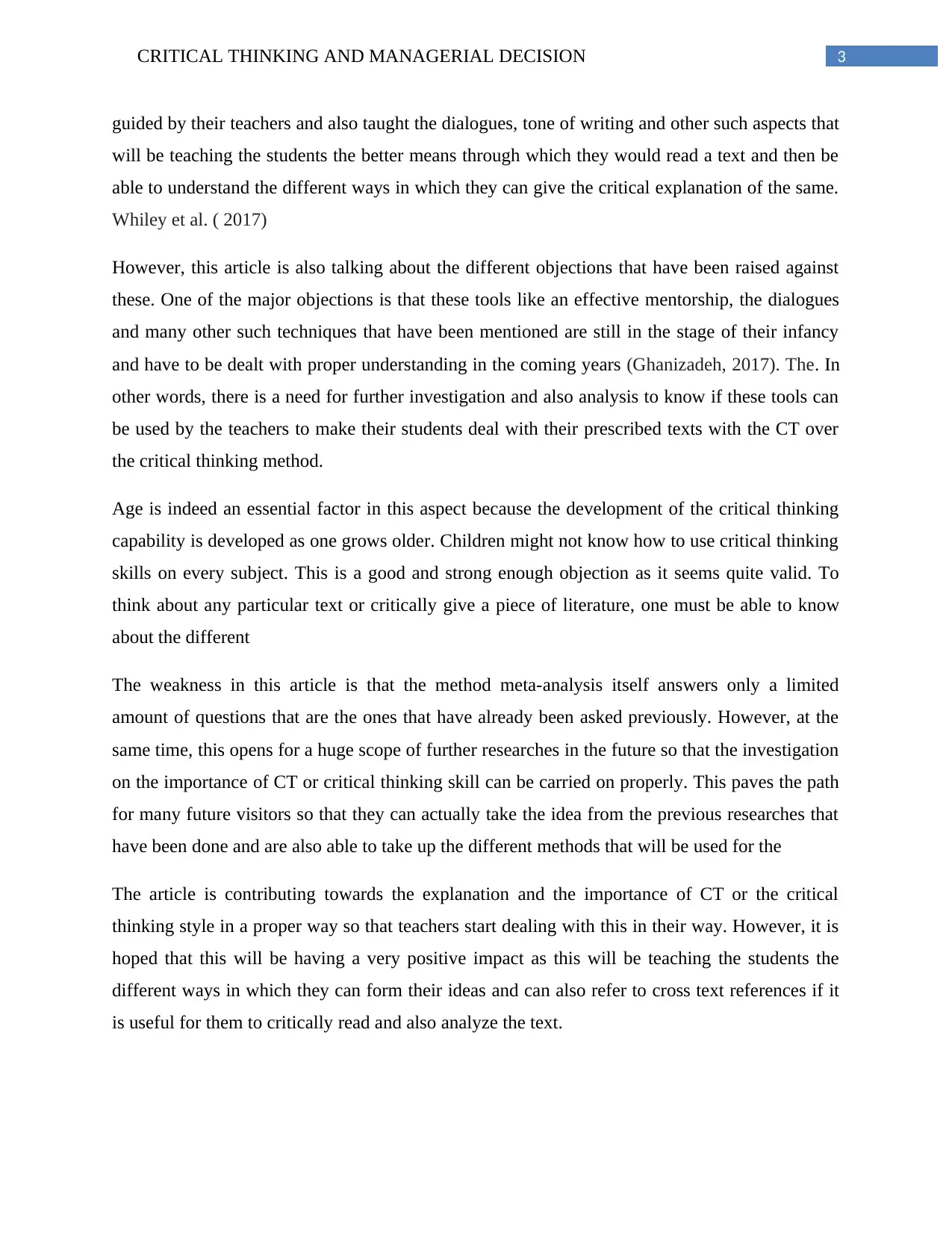
3CRITICAL THINKING AND MANAGERIAL DECISION
guided by their teachers and also taught the dialogues, tone of writing and other such aspects that
will be teaching the students the better means through which they would read a text and then be
able to understand the different ways in which they can give the critical explanation of the same.
Whiley et al. ( 2017)
However, this article is also talking about the different objections that have been raised against
these. One of the major objections is that these tools like an effective mentorship, the dialogues
and many other such techniques that have been mentioned are still in the stage of their infancy
and have to be dealt with proper understanding in the coming years (Ghanizadeh, 2017). The. In
other words, there is a need for further investigation and also analysis to know if these tools can
be used by the teachers to make their students deal with their prescribed texts with the CT over
the critical thinking method.
Age is indeed an essential factor in this aspect because the development of the critical thinking
capability is developed as one grows older. Children might not know how to use critical thinking
skills on every subject. This is a good and strong enough objection as it seems quite valid. To
think about any particular text or critically give a piece of literature, one must be able to know
about the different
The weakness in this article is that the method meta-analysis itself answers only a limited
amount of questions that are the ones that have already been asked previously. However, at the
same time, this opens for a huge scope of further researches in the future so that the investigation
on the importance of CT or critical thinking skill can be carried on properly. This paves the path
for many future visitors so that they can actually take the idea from the previous researches that
have been done and are also able to take up the different methods that will be used for the
The article is contributing towards the explanation and the importance of CT or the critical
thinking style in a proper way so that teachers start dealing with this in their way. However, it is
hoped that this will be having a very positive impact as this will be teaching the students the
different ways in which they can form their ideas and can also refer to cross text references if it
is useful for them to critically read and also analyze the text.
guided by their teachers and also taught the dialogues, tone of writing and other such aspects that
will be teaching the students the better means through which they would read a text and then be
able to understand the different ways in which they can give the critical explanation of the same.
Whiley et al. ( 2017)
However, this article is also talking about the different objections that have been raised against
these. One of the major objections is that these tools like an effective mentorship, the dialogues
and many other such techniques that have been mentioned are still in the stage of their infancy
and have to be dealt with proper understanding in the coming years (Ghanizadeh, 2017). The. In
other words, there is a need for further investigation and also analysis to know if these tools can
be used by the teachers to make their students deal with their prescribed texts with the CT over
the critical thinking method.
Age is indeed an essential factor in this aspect because the development of the critical thinking
capability is developed as one grows older. Children might not know how to use critical thinking
skills on every subject. This is a good and strong enough objection as it seems quite valid. To
think about any particular text or critically give a piece of literature, one must be able to know
about the different
The weakness in this article is that the method meta-analysis itself answers only a limited
amount of questions that are the ones that have already been asked previously. However, at the
same time, this opens for a huge scope of further researches in the future so that the investigation
on the importance of CT or critical thinking skill can be carried on properly. This paves the path
for many future visitors so that they can actually take the idea from the previous researches that
have been done and are also able to take up the different methods that will be used for the
The article is contributing towards the explanation and the importance of CT or the critical
thinking style in a proper way so that teachers start dealing with this in their way. However, it is
hoped that this will be having a very positive impact as this will be teaching the students the
different ways in which they can form their ideas and can also refer to cross text references if it
is useful for them to critically read and also analyze the text.
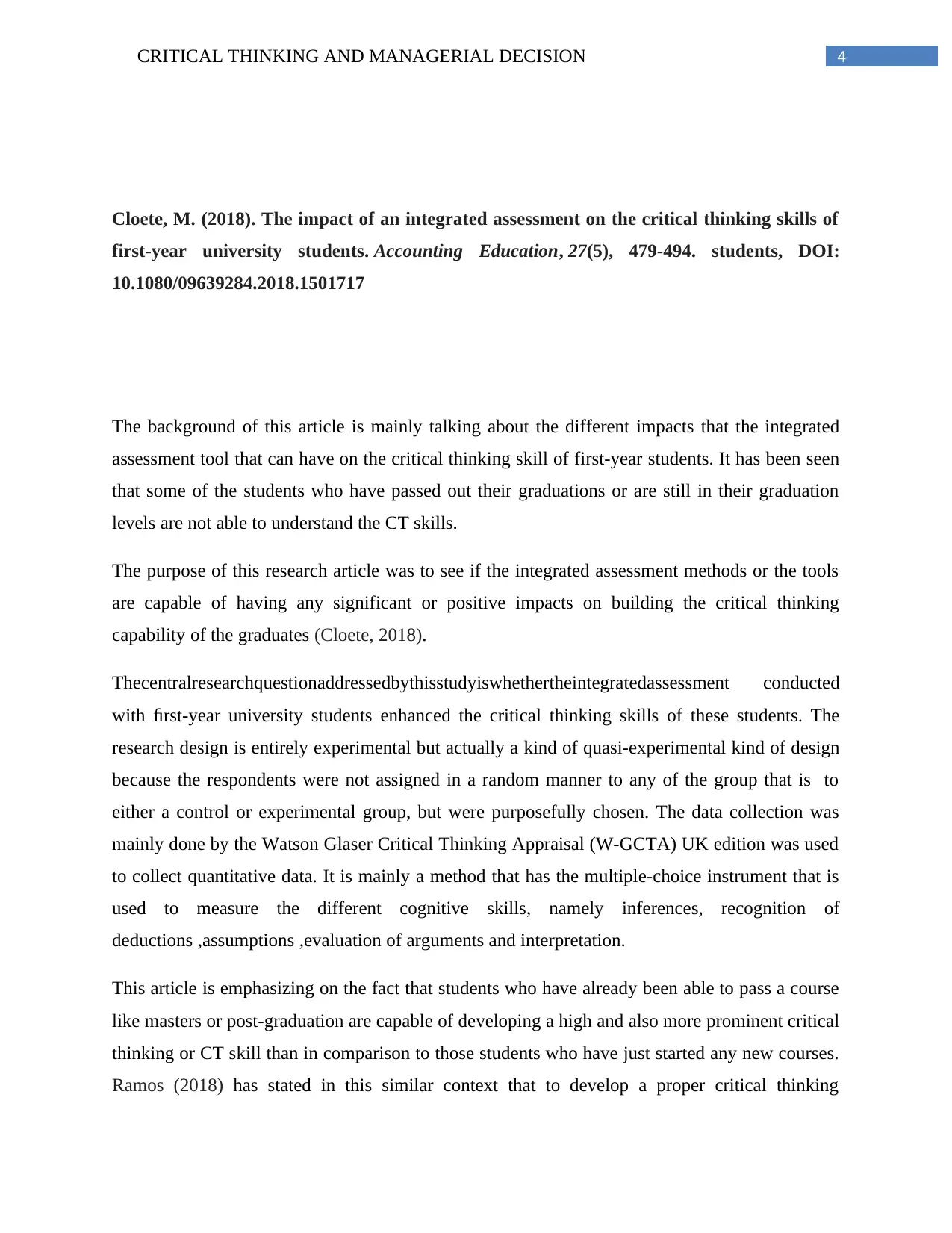
4CRITICAL THINKING AND MANAGERIAL DECISION
Cloete, M. (2018). The impact of an integrated assessment on the critical thinking skills of
first-year university students. Accounting Education, 27(5), 479-494. students, DOI:
10.1080/09639284.2018.1501717
The background of this article is mainly talking about the different impacts that the integrated
assessment tool that can have on the critical thinking skill of first-year students. It has been seen
that some of the students who have passed out their graduations or are still in their graduation
levels are not able to understand the CT skills.
The purpose of this research article was to see if the integrated assessment methods or the tools
are capable of having any significant or positive impacts on building the critical thinking
capability of the graduates (Cloete, 2018).
Thecentralresearchquestionaddressedbythisstudyiswhethertheintegratedassessment conducted
with first-year university students enhanced the critical thinking skills of these students. The
research design is entirely experimental but actually a kind of quasi-experimental kind of design
because the respondents were not assigned in a random manner to any of the group that is to
either a control or experimental group, but were purposefully chosen. The data collection was
mainly done by the Watson Glaser Critical Thinking Appraisal (W-GCTA) UK edition was used
to collect quantitative data. It is mainly a method that has the multiple-choice instrument that is
used to measure the different cognitive skills, namely inferences, recognition of
deductions ,assumptions ,evaluation of arguments and interpretation.
This article is emphasizing on the fact that students who have already been able to pass a course
like masters or post-graduation are capable of developing a high and also more prominent critical
thinking or CT skill than in comparison to those students who have just started any new courses.
Ramos (2018) has stated in this similar context that to develop a proper critical thinking
Cloete, M. (2018). The impact of an integrated assessment on the critical thinking skills of
first-year university students. Accounting Education, 27(5), 479-494. students, DOI:
10.1080/09639284.2018.1501717
The background of this article is mainly talking about the different impacts that the integrated
assessment tool that can have on the critical thinking skill of first-year students. It has been seen
that some of the students who have passed out their graduations or are still in their graduation
levels are not able to understand the CT skills.
The purpose of this research article was to see if the integrated assessment methods or the tools
are capable of having any significant or positive impacts on building the critical thinking
capability of the graduates (Cloete, 2018).
Thecentralresearchquestionaddressedbythisstudyiswhethertheintegratedassessment conducted
with first-year university students enhanced the critical thinking skills of these students. The
research design is entirely experimental but actually a kind of quasi-experimental kind of design
because the respondents were not assigned in a random manner to any of the group that is to
either a control or experimental group, but were purposefully chosen. The data collection was
mainly done by the Watson Glaser Critical Thinking Appraisal (W-GCTA) UK edition was used
to collect quantitative data. It is mainly a method that has the multiple-choice instrument that is
used to measure the different cognitive skills, namely inferences, recognition of
deductions ,assumptions ,evaluation of arguments and interpretation.
This article is emphasizing on the fact that students who have already been able to pass a course
like masters or post-graduation are capable of developing a high and also more prominent critical
thinking or CT skill than in comparison to those students who have just started any new courses.
Ramos (2018) has stated in this similar context that to develop a proper critical thinking
Secure Best Marks with AI Grader
Need help grading? Try our AI Grader for instant feedback on your assignments.
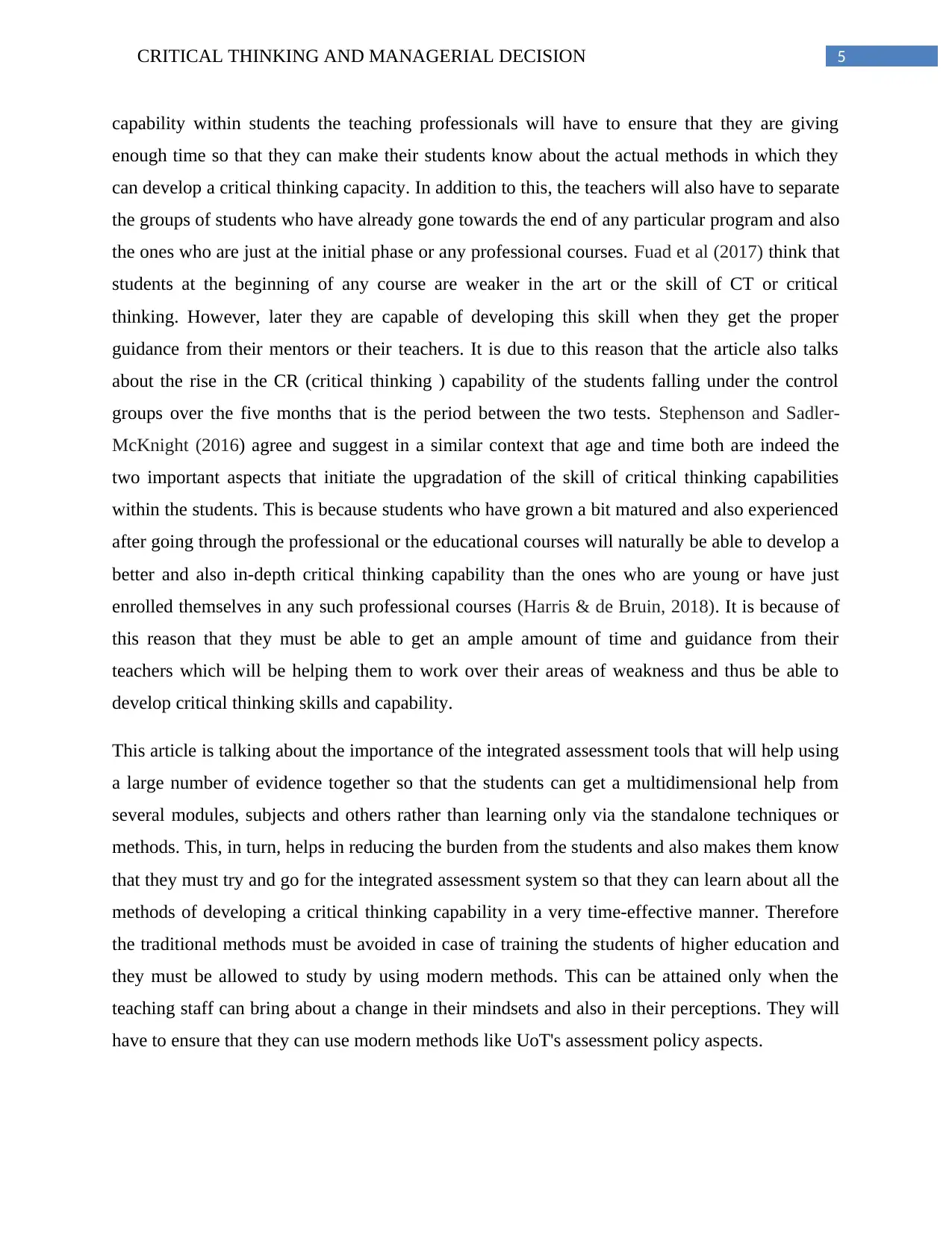
5CRITICAL THINKING AND MANAGERIAL DECISION
capability within students the teaching professionals will have to ensure that they are giving
enough time so that they can make their students know about the actual methods in which they
can develop a critical thinking capacity. In addition to this, the teachers will also have to separate
the groups of students who have already gone towards the end of any particular program and also
the ones who are just at the initial phase or any professional courses. Fuad et al (2017) think that
students at the beginning of any course are weaker in the art or the skill of CT or critical
thinking. However, later they are capable of developing this skill when they get the proper
guidance from their mentors or their teachers. It is due to this reason that the article also talks
about the rise in the CR (critical thinking ) capability of the students falling under the control
groups over the five months that is the period between the two tests. Stephenson and Sadler-
McKnight (2016) agree and suggest in a similar context that age and time both are indeed the
two important aspects that initiate the upgradation of the skill of critical thinking capabilities
within the students. This is because students who have grown a bit matured and also experienced
after going through the professional or the educational courses will naturally be able to develop a
better and also in-depth critical thinking capability than the ones who are young or have just
enrolled themselves in any such professional courses (Harris & de Bruin, 2018). It is because of
this reason that they must be able to get an ample amount of time and guidance from their
teachers which will be helping them to work over their areas of weakness and thus be able to
develop critical thinking skills and capability.
This article is talking about the importance of the integrated assessment tools that will help using
a large number of evidence together so that the students can get a multidimensional help from
several modules, subjects and others rather than learning only via the standalone techniques or
methods. This, in turn, helps in reducing the burden from the students and also makes them know
that they must try and go for the integrated assessment system so that they can learn about all the
methods of developing a critical thinking capability in a very time-effective manner. Therefore
the traditional methods must be avoided in case of training the students of higher education and
they must be allowed to study by using modern methods. This can be attained only when the
teaching staff can bring about a change in their mindsets and also in their perceptions. They will
have to ensure that they can use modern methods like UoT's assessment policy aspects.
capability within students the teaching professionals will have to ensure that they are giving
enough time so that they can make their students know about the actual methods in which they
can develop a critical thinking capacity. In addition to this, the teachers will also have to separate
the groups of students who have already gone towards the end of any particular program and also
the ones who are just at the initial phase or any professional courses. Fuad et al (2017) think that
students at the beginning of any course are weaker in the art or the skill of CT or critical
thinking. However, later they are capable of developing this skill when they get the proper
guidance from their mentors or their teachers. It is due to this reason that the article also talks
about the rise in the CR (critical thinking ) capability of the students falling under the control
groups over the five months that is the period between the two tests. Stephenson and Sadler-
McKnight (2016) agree and suggest in a similar context that age and time both are indeed the
two important aspects that initiate the upgradation of the skill of critical thinking capabilities
within the students. This is because students who have grown a bit matured and also experienced
after going through the professional or the educational courses will naturally be able to develop a
better and also in-depth critical thinking capability than the ones who are young or have just
enrolled themselves in any such professional courses (Harris & de Bruin, 2018). It is because of
this reason that they must be able to get an ample amount of time and guidance from their
teachers which will be helping them to work over their areas of weakness and thus be able to
develop critical thinking skills and capability.
This article is talking about the importance of the integrated assessment tools that will help using
a large number of evidence together so that the students can get a multidimensional help from
several modules, subjects and others rather than learning only via the standalone techniques or
methods. This, in turn, helps in reducing the burden from the students and also makes them know
that they must try and go for the integrated assessment system so that they can learn about all the
methods of developing a critical thinking capability in a very time-effective manner. Therefore
the traditional methods must be avoided in case of training the students of higher education and
they must be allowed to study by using modern methods. This can be attained only when the
teaching staff can bring about a change in their mindsets and also in their perceptions. They will
have to ensure that they can use modern methods like UoT's assessment policy aspects.
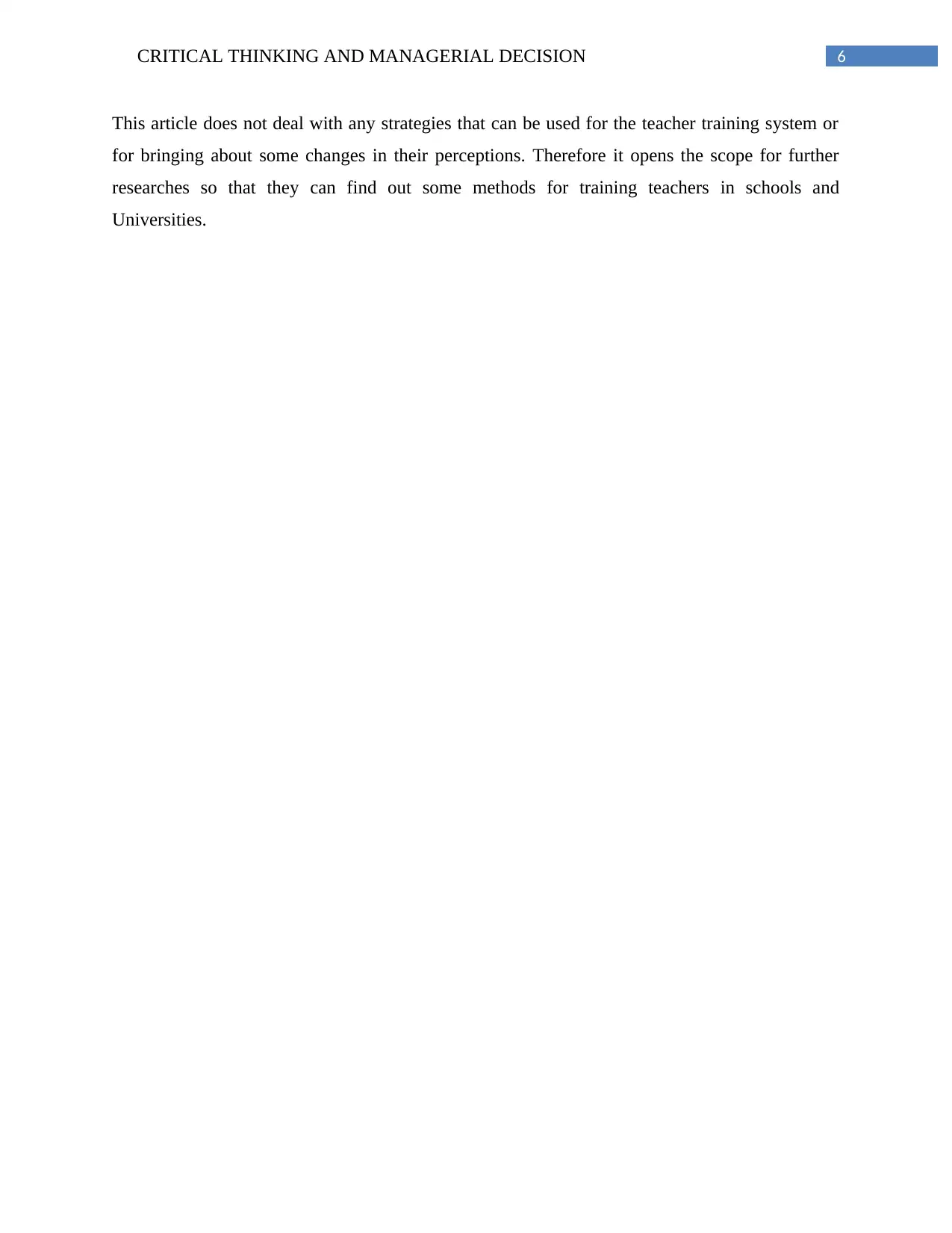
6CRITICAL THINKING AND MANAGERIAL DECISION
This article does not deal with any strategies that can be used for the teacher training system or
for bringing about some changes in their perceptions. Therefore it opens the scope for further
researches so that they can find out some methods for training teachers in schools and
Universities.
This article does not deal with any strategies that can be used for the teacher training system or
for bringing about some changes in their perceptions. Therefore it opens the scope for further
researches so that they can find out some methods for training teachers in schools and
Universities.
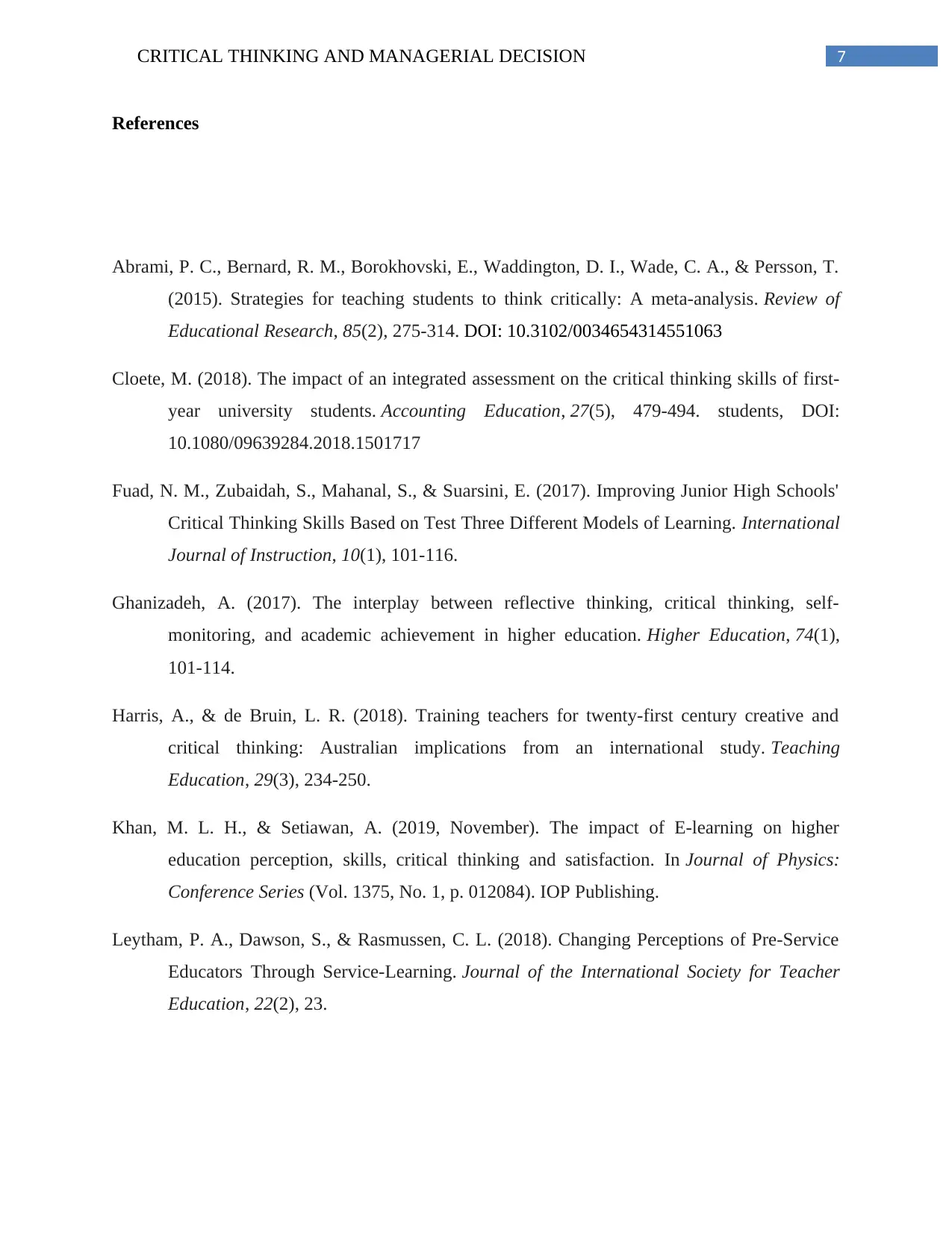
7CRITICAL THINKING AND MANAGERIAL DECISION
References
Abrami, P. C., Bernard, R. M., Borokhovski, E., Waddington, D. I., Wade, C. A., & Persson, T.
(2015). Strategies for teaching students to think critically: A meta-analysis. Review of
Educational Research, 85(2), 275-314. DOI: 10.3102/0034654314551063
Cloete, M. (2018). The impact of an integrated assessment on the critical thinking skills of first-
year university students. Accounting Education, 27(5), 479-494. students, DOI:
10.1080/09639284.2018.1501717
Fuad, N. M., Zubaidah, S., Mahanal, S., & Suarsini, E. (2017). Improving Junior High Schools'
Critical Thinking Skills Based on Test Three Different Models of Learning. International
Journal of Instruction, 10(1), 101-116.
Ghanizadeh, A. (2017). The interplay between reflective thinking, critical thinking, self-
monitoring, and academic achievement in higher education. Higher Education, 74(1),
101-114.
Harris, A., & de Bruin, L. R. (2018). Training teachers for twenty-first century creative and
critical thinking: Australian implications from an international study. Teaching
Education, 29(3), 234-250.
Khan, M. L. H., & Setiawan, A. (2019, November). The impact of E-learning on higher
education perception, skills, critical thinking and satisfaction. In Journal of Physics:
Conference Series (Vol. 1375, No. 1, p. 012084). IOP Publishing.
Leytham, P. A., Dawson, S., & Rasmussen, C. L. (2018). Changing Perceptions of Pre-Service
Educators Through Service-Learning. Journal of the International Society for Teacher
Education, 22(2), 23.
References
Abrami, P. C., Bernard, R. M., Borokhovski, E., Waddington, D. I., Wade, C. A., & Persson, T.
(2015). Strategies for teaching students to think critically: A meta-analysis. Review of
Educational Research, 85(2), 275-314. DOI: 10.3102/0034654314551063
Cloete, M. (2018). The impact of an integrated assessment on the critical thinking skills of first-
year university students. Accounting Education, 27(5), 479-494. students, DOI:
10.1080/09639284.2018.1501717
Fuad, N. M., Zubaidah, S., Mahanal, S., & Suarsini, E. (2017). Improving Junior High Schools'
Critical Thinking Skills Based on Test Three Different Models of Learning. International
Journal of Instruction, 10(1), 101-116.
Ghanizadeh, A. (2017). The interplay between reflective thinking, critical thinking, self-
monitoring, and academic achievement in higher education. Higher Education, 74(1),
101-114.
Harris, A., & de Bruin, L. R. (2018). Training teachers for twenty-first century creative and
critical thinking: Australian implications from an international study. Teaching
Education, 29(3), 234-250.
Khan, M. L. H., & Setiawan, A. (2019, November). The impact of E-learning on higher
education perception, skills, critical thinking and satisfaction. In Journal of Physics:
Conference Series (Vol. 1375, No. 1, p. 012084). IOP Publishing.
Leytham, P. A., Dawson, S., & Rasmussen, C. L. (2018). Changing Perceptions of Pre-Service
Educators Through Service-Learning. Journal of the International Society for Teacher
Education, 22(2), 23.
Paraphrase This Document
Need a fresh take? Get an instant paraphrase of this document with our AI Paraphraser
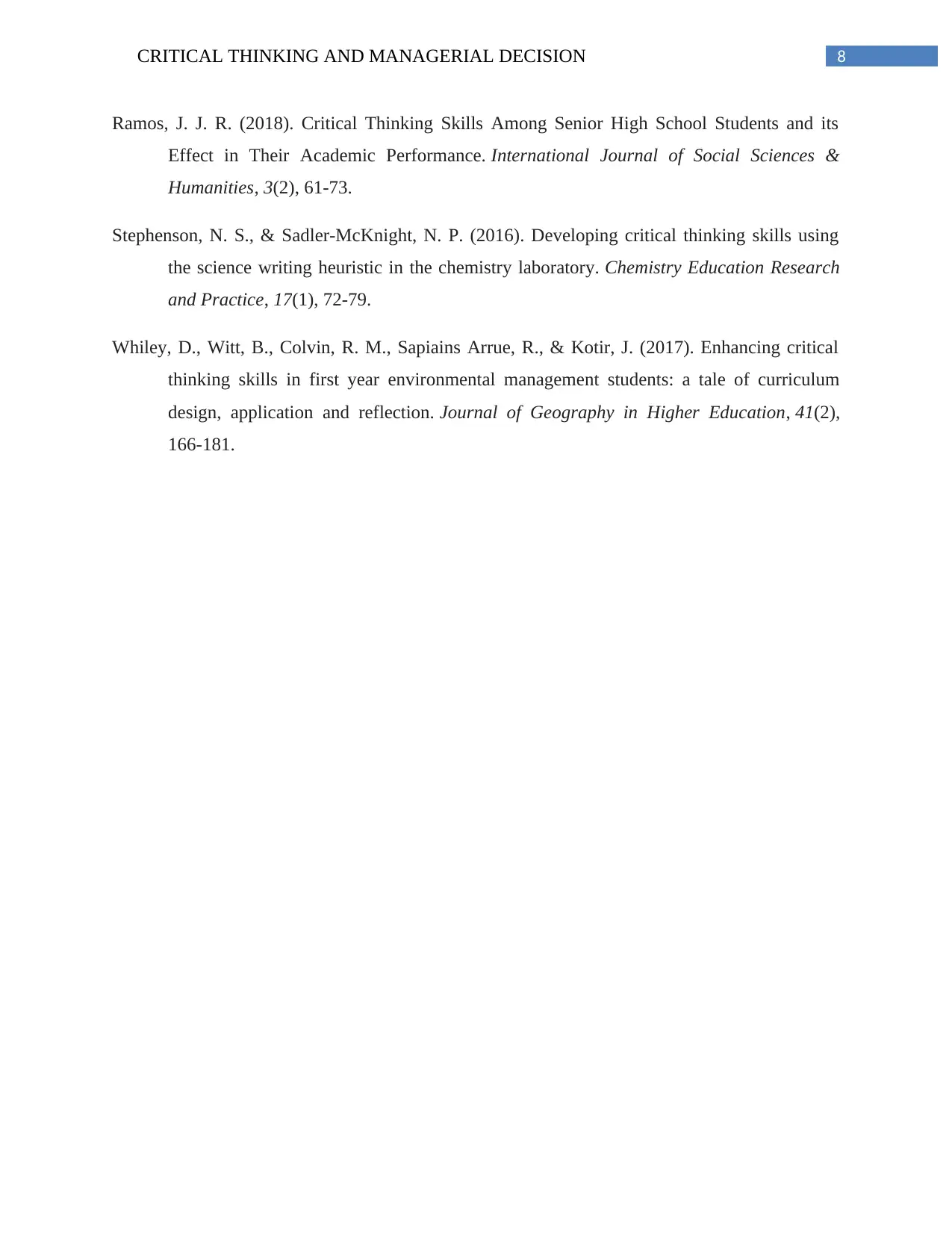
8CRITICAL THINKING AND MANAGERIAL DECISION
Ramos, J. J. R. (2018). Critical Thinking Skills Among Senior High School Students and its
Effect in Their Academic Performance. International Journal of Social Sciences &
Humanities, 3(2), 61-73.
Stephenson, N. S., & Sadler-McKnight, N. P. (2016). Developing critical thinking skills using
the science writing heuristic in the chemistry laboratory. Chemistry Education Research
and Practice, 17(1), 72-79.
Whiley, D., Witt, B., Colvin, R. M., Sapiains Arrue, R., & Kotir, J. (2017). Enhancing critical
thinking skills in first year environmental management students: a tale of curriculum
design, application and reflection. Journal of Geography in Higher Education, 41(2),
166-181.
Ramos, J. J. R. (2018). Critical Thinking Skills Among Senior High School Students and its
Effect in Their Academic Performance. International Journal of Social Sciences &
Humanities, 3(2), 61-73.
Stephenson, N. S., & Sadler-McKnight, N. P. (2016). Developing critical thinking skills using
the science writing heuristic in the chemistry laboratory. Chemistry Education Research
and Practice, 17(1), 72-79.
Whiley, D., Witt, B., Colvin, R. M., Sapiains Arrue, R., & Kotir, J. (2017). Enhancing critical
thinking skills in first year environmental management students: a tale of curriculum
design, application and reflection. Journal of Geography in Higher Education, 41(2),
166-181.
1 out of 8
Related Documents
Your All-in-One AI-Powered Toolkit for Academic Success.
+13062052269
info@desklib.com
Available 24*7 on WhatsApp / Email
![[object Object]](/_next/static/media/star-bottom.7253800d.svg)
Unlock your academic potential
© 2024 | Zucol Services PVT LTD | All rights reserved.





